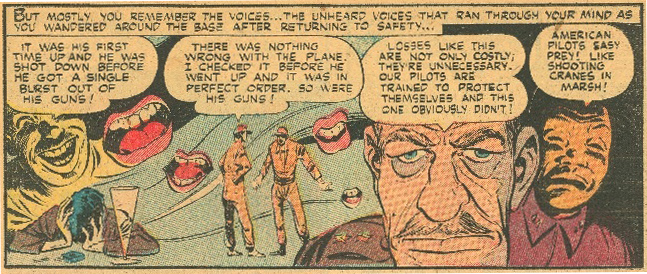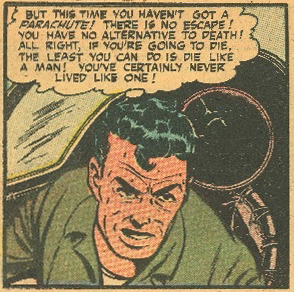The comic “Flight into Fury,” published in The United States Marines No. 8, is an intense second person narrative which places the reader in the shoes of a pilot about to embark on his first mission after being shot down over enemy territory. The comic addresses issues of traumatic events and the questioning of one’s own abilities with some complexity and understanding, though the protagonist resolves his issues through bearing down and acting without regard for his own well-being.
The comic opens with the protagonist, who later comes to be known as Joe,[^] standing on a runway wondering, “Can you trust yourself?…You who remember so vividly that terrible - Flight into Fury,” and begins walking the reader through the terrifying memories that haunt the protagonist.[^] His self-doubt and the damage to his reputation are paralyzing. The next panel reads, “But mostly you remember the voices…the unheard voices that ran through your mind as you wandered around the base after returning to safety…” and a haunting dream sequence is shown across the panel, with disappointment, depression, mocking, and laughter.[^]
As a soldier on the ground, Joe withstands an intense attack, and he disobeys orders to hold the position and orders the men to move to a ridge in preparation for another attack. He questioned his own motives, saying “Why don’t you face it? You’re not thinking of the men…you’re thinking of yourself. You’re afraid to tell them they have to withstand another attack like that! You’re a coward…A COWARD! A COWARD!!!!”[^] On the ridge, additional troops converge on the location, and the protagonist, in a rush, turns and fires upon them. He is stopped when another soldier realizes that the troops are American.[^] His superior excoriates him, saying his decision to take the ridge cost them men and, because the enemy is able to bring up artillery, left their position almost hopeless.[^]
As these thoughts go through his head, he is faced with an opportunity to redeem himself. He spots an abandoned enemy plane and contemplates attacking the enemy artillery, while battling insecurity: “But do you have the courage? Can you step inside that thing and do the things you’re supposed to be able to do? Can you conquer your fears? Or are you going to be a coward all your life?”[^] The protagonist is hampered by self-doubt and doubts of his peers, and must do something drastic to win them over and assuage his own doubts.
Without much further narration, he is up in the air, searching for the enemy artillery. He destroys the installment and encounters some enemy MiGs, and is reminded of his painful past. He realizes that his back is against the wall this time. He receives enemy fire, but is still able to maneuver and attack the MiGs. He tells himself, “But this time you haven’t got a parachute! There is no escape! You have no alternative to death! All right, if you’re going to die, the least you can do is die like a man! You’ve certainly never lived like one!”[^] With the situation clear - kill or be killed - he finds new determination to take out as many MiGs as possible before he goes down. He shoots down another plane and then notices the remaining MiG running. He says, “He’s running! He’s actually running from me! He’s more scared than I am! He’s afraid of me!!!”[^]
The next thing he remembers after this triumphant realization is waking up in a hospital with an officer referred to as ‘the old man’ sitting beside him.[^] Joe learns that his crew was able to hold out for reinforcements thanks to his work.[^] The officer adds, “One thing I can’t understand, though, is how a guy who can fly like that didn’t stick to aviation,” prompting Joe to say that he found his own worst enemy, but “The guy is dead now…His name was Joe.”[^]
Joe is able to elevate above his own paralyzing memories and fear by just bearing down and pushing through, and engaging a deadly rogue mission to save his unit and make up for his mistake. He decides to “be a man” and block out any thoughts that would deter him, becoming a war hero in the process. The traits of aggression and courage are primarily displayed as the way to “be a man” as well as a successful soldier. His cowardice, on the other hand, cost the lives of many friendly soldiers.His prior lack of aggression had prevented him from being a man prior to this event, and this thrust of aggression and fearlessness was what he felt he needed to finally become a man.
Related Sections
- Adventurousness & Aggressiveness
- Adventurousness & Aggressiveness - A'feudin' and A'fightin'
- Adventurousness & Aggressiveness - Defend Your Country
- Adventurousness & Aggressiveness - Li’l Abner Joins the Navy!
- Adventurousness & Aggressiveness - Palau
- Adventurousness & Aggressiveness - Pvt. Droop Has Missed the War!
- Adventurousness & Aggressiveness - Saipan
- Adventurousness & Aggressiveness - Tarawa
- Adventurousness & Aggressiveness - The Fighting Redhead
- Adventurousness & Aggressiveness - Vanguard of Doom
- Inexpressiveness and Independence - Flight into Fury
Primary Sources






